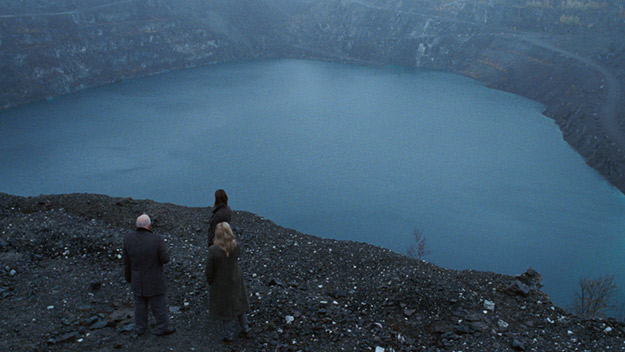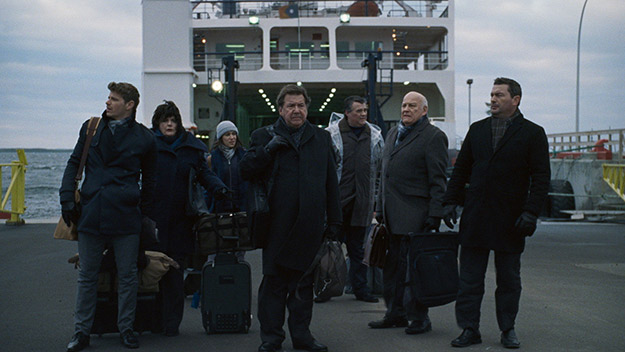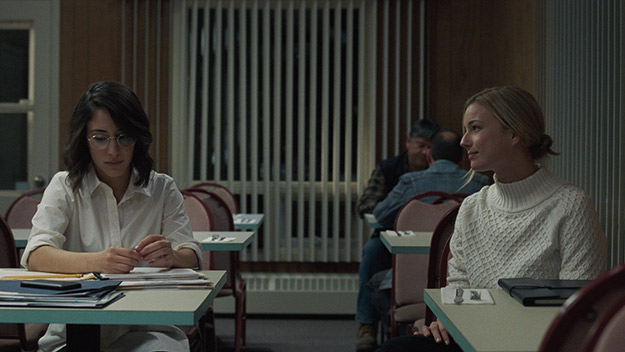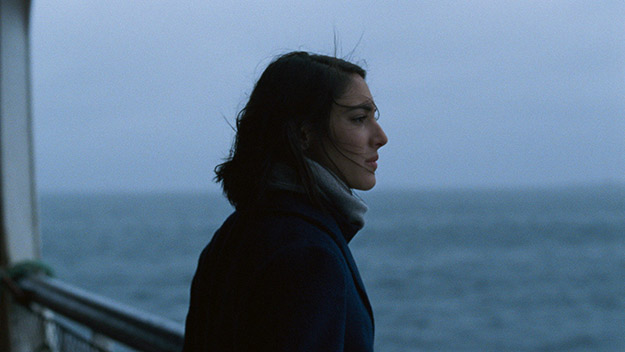Robichaud’s previous work, particularly her 2013 debut feature Sarah Prefers to Run, explores the role of choice and experience in articulating identity. Rather than unify her characters in Boundaries with a declarative thesis on women in politics, Robichaud gives them space to independently process their experiences and shape their futures accordingly. Reflecting on her decision to quit high-school cheerleading, Emily admits to Félixe, “I liked the sport, but not everything that went with it”—Boundaries stages the dance of negotiation along with its accompanying aggravations, but then challenges its characters to find their own ways through it, or even out of it. Prior to this weekend’s screenings, Film Comment spoke with Robichaud by phone about creating Besco’s aesthetics and atmosphere, shooting a film inspired by ’70s cinematography, and collaborating on a jazz score. How do you approach the framing of your characters? In Boundaries, you introduce them through these ID-style, medium close-ups, and in Sarah Prefers to Run, you’re very careful about how you use close-ups of feet or body parts. To me, a close-up must be used in a way that says something about the character. I often find that we overuse close-ups in films. To me, it has to at least say something relevant and you have to capture the interior feelings of the character. So I try to go from wide shots to close-ups to say, just watch. Watch the way my actors are looking at things, how they’re acting. It’s not about what they are saying, it’s about how they perceive and act in the world they are in. My mise en scène is all about being with them at the right moment, I suppose. In Sarah Prefers to Run, Sarah is not speaking with her words, but I think her body is saying a lot about how she reacts to other women. So my camera is just a way of making the spectator aware of those details. And I think it’s the same in life—sometimes we’re just listening to people, but we’re not paying enough attention to the body language. I think it’s a film director’s job to help you see what you’re maybe not seeing in real life. You’ve spoken a bit about how a network narrative seemed like a good way for Boundaries to examine different characters in different stages of life. We see that in [your Web series] Féminin/Féminin, too, with each episode focusing on a different character or relationship. Was an ensemble narrative something you wanted to explore after Sarah Prefers to Run and your first few shorts? I think so. For Boundaries, it was very natural at first to have at least three characters, to have a spectrum of different choices and experiences, because if the film was only about Félixe, to me it would have been a way of saying that women in politics are just like Félixe. But I think there are very diverse experiences and issues for women who have important careers. So these three women, at the end, they’re not making the same choices. One might choose a new career, one her family, one who’s just trying to find a balance. So to have this construction with three characters helped me build my ideas about these social issues. You mentioned revealing what’s under the surface of your characters’ conversations through your camera. I’m curious about your choice to use documentary techniques in Boundaries—in the press-conference scene, you adjust your camera using these jerky zooms in the style of news cameras that arrive on the scene. And you give us documentary-style exit blurbs for each character, too. How did you approach these perspective choices? I try to find the right balance between what feels realistic and what feels aesthetic. I guess there is a documentary approach in the way that I direct actors. I want my film to look and to feel, as much as I can, like reality, like real human beings interacting with each other. I’m not trying to emphasize emotions that sometimes aren’t emphasized in real life. For Boundaries, I wanted to play in between what’s fiction and what’s real, so that’s why the film also starts with the title card “inspired by true events”—even though the film is not. I think when we watch films, we forget that we’re always watching a part of humanity, and things that do happen. And even though my three main characters are not real, I think many women can relate to the issues they face. So that’s maybe why my mise en scène has influences of documentary, so that we are aware, again, that we’re seeing a film, or that we’re seeing a part of what’s around us nowadays. You get that sense as well with Féminin/Féminin, because you’re present in the narrative with a documentary crew. Yeah, they are characters, but I’m pretty sure that a lot of people can relate to what they are saying and what they are experiencing. Also in Féminin/Féminin, a lot of the script was based on my friends and girls around me and my own reality in Montreal, so I thought it was just really natural to be a part of it, and be open about saying that this is also about me.
Your films explore introversion in a nuanced way, but you also give your characters moments of release when they connect to each other, or find a nonverbal outlet for their emotions. How do you go about dramatizing these moments? I think that introverts have a lot to say, and they do feel a lot. I would say I was an introvert, but maybe I’m opening myself up more now that I’m an adult. I wish people would just listen more and be aware of those who might seem to be in the margin, and might seem very different from them. When Sarah Prefers to Run was first released, there were some critics. Some people were saying, “She’s cold, she’s not speaking, what’s going on?” But many others told me, “It’s so nice to have a character like this one, because I’m like this, and I’m never represented on screen.” That’s my way, I hope, to make people aware of those who seem different. All of the characters in Boundaries experience a lot of loneliness, but when they interact, I think there’s a relief. Well, maybe that’s what I see right now. In my job, there can be moments of loneliness when writing a film, but when you interact with others and connect with them, I think it’s a relief for everyone. That relief can be a physical release too—particularly through song, like the scene where Félixe sings, or the karaoke scene from Sarah Prefers to Run. I use music as a way of expressing the inner feelings of my characters. Like I said, sometimes we’re saying words, but we’re not really saying what we feel inside. I think music is often used nowadays as a way of expressing ourselves. When I was a teenager, we used MSN Messenger, and we were always writing titles of songs to express our feelings of the day. I think it’s really interesting because we were too shy to really say what was going on. We used music to pass a message, or something. My characters also kind of do this. It’s the subconscious, too, that finds a path with music. Boundaries becomes so much about what you cultivate in your own personal landscapes, and where you put resources. And the political element acts as a metaphor for that, too. When I started writing the script, I soon realized I needed to have a political conflict. I started reading about the mining industry, and how mining companies are exploiting a lot of territory. Very little money goes back to the communities. We have to speak about that. There’s nothing sexy about the mining industry in the cinema; it’s not something where you’d be like, “Oh yeah, let’s make a film about the mining industry.” But I thought, “Why not?” Maybe I could use my film and raise questions about that. Can we take back our resources? As a community, we should be more interested in how companies are using our resources right now. To me, the first thing about the film was making the psychology up-front about these three characters, but the political conflict, and these social issues, also feel very important. What we’re doing to the environment right now is a really sensitive subject, and I think a lot of people from my generation are asking questions, because it’s all about the future. So maybe that’s why I was curious about the subject of the mining industry. Speaking of climate, you have that shot of the iceberg breaking at the end of the montage set to Jacques Brel. Could you tell me more about that shot? Yes! At the end of Jacques Brel, you have the iceberg. [Getting that shot] was a very lucky moment. We were filming icebergs all around Newfoundland in June, ahead of shooting the film in October. I knew I wanted icebergs because, to me, they are a great metaphor for what’s happening right now with the environment. We were filming one, and it just broke in front of us. We were very lucky because we were filming on 35mm, and did not have a lot of footage. It was a beautiful moment. My crew and I, we were just crying. It was so beautiful to see, and it stayed with me throughout filming. I knew I had to place that particular moment at a specific time in the film—so it comes right in the middle, when you feel that something’s going to happen with the characters. When the women first come to Besco they feel optimistic that they’re going to participate in change, but by the middle of the film they feel disillusioned. I think the iceberg is a marking point that something will be different, and they will make decisions for themselves.
Let’s talk more about shooting in Newfoundland. You said you shot on 35mm? Yeah, we shot in Newfoundland, on Fogo Island, and in St. John’s. I always choose my locations very specifically. Me and Jessica Lee Gagné, who’s the DP, we’ve worked together for 12 years now, since we were kids—and it’s always all about locations. We worked a lot in pre-production on finding the right colors, the right lines. We’re very into details. We went, like five times, to Newfoundland, to find the right places and the right framings. We traveled all across Newfoundland to have the most beautiful landscape for the film. Jessica and I speak a lot about the films, about the characters, about my way of seeing the mise en scène. So to me, it’s all about being really prepared, so that when I come on set I can be with my actors. Everyone knows what to do, and I’m there to direct actors and that’s all. We shot on 35mm because there’s a nostalgia in the film. You mentioned the zooms, and even in the textures, the costumes, and the colors of the film, we created this ’70s ambiance. It wasn’t for fun or an aesthetic; it was a way of saying that this island is kind of stuck in the past, like a lot of mining cities or countries. There were a lot of cities that had a really good economic boost in the ’70s and then it just crashed. They’re trying to get on with modernity, but they’re stuck. So that’s why I chose to shoot on 35mm. And also because I think 35mm is amazing! It’s beautiful. Since Besco is a fictitious island, it needed to have its own personality. Since the film would be mostly shown in Quebec, it had to feel close, but at the same time far away from us, so that was really the difficulty of the film, finding that balance. And I think having the different color palette and the retro style was another way to give a specific personality to the island. In terms of the look of the film, I noticed a lot of photographs of landscapes inside the hotel rooms, and the image of the waterfall on the vending machine. Could you talk about those production-design choices? The way I see it, like I explained to the art director [Carolyne de Bellefeuille], is that they’re speaking about how they’re going to exploit the resources, but they’re forgetting the landscape and what it means. So I set the negotiations inside a primary school gym, and it’s claustrophobic, but I wanted to have those tiny details that would remind them of those landscapes and their resources. We do see the landscape through Félixe. She’s the one who is really interested in people, and she wants to know about the environment. I think she’s a great ambassador of the youth right now—that’s my way of seeing it—who are really open and aware of the environment and the world. We talk a lot about how for our younger generation there are no frontiers. They travel a lot; they want to meet people and see the world, and Félixe is a good example of that. She also embodies the conflict of wanting to get involved in politics to make a difference but then facing constraints, limits, and bureaucracy. We all have our ideas of how we want to change the world. I’m pretty sure most politicians, when they entered politics, were like Félixe. The world of politics is too big. You think you’ve elected people, but it’s sometimes not the people you’ve elected that are making the decisions. I think Félixe is maybe naïve when starting her career, and then she’s confronted with that reality. So that’s why, at the end, she leaves her party and is trying to figure out how to found her own party, a new party. Maybe that’s something we’re going to see in the next few years—well, I’m talking about Quebec or Canada—a movement about how we can make politics different. I think the structure of politics right now is getting old. I want the spectator to leave and have these same reflections about whether they might want to learn more about politics, or if they want to have more education as a citizen, or not. I’m leaving it to them. We could say that the rogue shooter who causes the lockdown at the end of the film is kind of dark. But in the end, these women, the other characters, and the spectators of the film, as citizens, can say that we can have a positive change. It’s not cynical. So, I’m trying to be optimistic about what’s ahead, but I’m also trying to be realistic by showing the reality right now.
I wanted to ask about how the jazz score came about. Did you collaborate with a composer about your vision for the music? Boundaries is the first time I’ve worked with a composer. For my first project, I didn’t really have money [for an original score], so I used songs instead. This is the first time I’ve had the budget to explore a film with a composer, and I had the chance to work with someone very great, Simon Bertrand. This film was always about jazz music; I listened to a lot of jazz while writing. I suppose that’s because of the nostalgic feeling of the music, but also because the politics are really about improv. Even the mediation scene is people bouncing ideas off of each other and trying to insult one another, but then trying to find solutions. After that, it moves one way or another. So I thought jazz would make us feel that flow. It would also create a very different atmosphere to give personality to the film and to the island, so Besco could be an island in itself with its own characteristics. At first, I sent [Bertrand] some music that I was listening to, just to say, “Well, this is what I see.” And he read different versions of the script. He was involved maybe a year before filming, so we had a lot of discussions about it. Then he was very encouraged to write some music even before we went out to film. So I was on set, and I had maybe five songs, and other examples of music that we would use later. Sometimes on set, I would put the music on so that the actors would immerse themselves in the atmosphere of the film. It was a great way of doing it. I wish I could do that for other films. The actors told me they really enjoyed it. They could understand my mise en scène in this way, and the tone of the film, and the rhythm of it. We made adjustments in post-production, but the songs we used were mostly ones that we had before filming. Do you typically rehearse like this to get your actors into the mindset of the film, or to set the mood? The important thing to me is not rehearsing but getting to know the actors. So I try to see the actors as much as I can before filming. We go have dinner or coffee, and we talk about how they see the characters and how they perceive the film. I asked them to read a lot about politics. I gave them specific books about the mining industry in Canada and Argentina. I think they did read some of them. I also sent different political films and series, like West Wing, which is one of the greatest. They had homework to do, and we would just talk. I’d also talk about myself, because I think to have a great relationship, it’s not only about them giving me something. I have to give something in return. So we learned about each other. On set, I think when actors know the characters, they’re left to getting at the emotions. There are different techniques, but I don’t like rehearsing because then you’re trying to get to a result that you might not have again when you’re filming—you will be on location, and there will be the camera, and the set, and it’s different. I also like the spontaneity that you get from just one take, the first take. In my experience with directing, the first takes are usually the best, because they come closer to the emotions that we have in real life.



